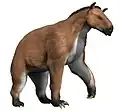| Nestoritherium Temporal range: Late Miocene to Early Pleistocene | |
|---|---|
| Scientific classification | |
| Domain: | Eukaryota |
| Kingdom: | Animalia |
| Phylum: | Chordata |
| Class: | Mammalia |
| Order: | Perissodactyla |
| Family: | †Chalicotheriidae |
| Subfamily: | †Chalicotheriinae |
| Genus: | †Nestoritherium Kaup, 1859 |
| Type species | |
| †Nestoritherium sivalense Falconer & Cautley, 1837 | |
| Species | |
| |
Nestoritherium is an extinct genus of chalicothere; it has been dated to have lived from the late Miocene to the Early Pleistocene (11.6–0.781 mya).[2][3][4] This range makes Nestoritherium one of the most recently dated chalicotheres. It has been found in fossil sites in Myanmar and China.[4]
The genus Nestoritherium was erected by German paleontologist Johann Jakob Kaup in 1859 for the species then known as Chalicotherium sivalense,[5] itself named in 1843 by Falconer and Cautley from early Pleistocene material from India.[6] The shortened faced and brachyodont dentition suggests it belongs to the subfamily Chalicotheriinae.[1]
Nestoritherium fuguense was named from partial lower jaw and palate material from Miocene beds in Fugu County, China in 2014.[6]
Material consisting of a fragmentary upper and lower molar recovered from the (early Pleistocene) Irrawaddy Formation in Myanmar has been referred to the genus Nestoritherium.[7] A femur of possible chalicothere origin was recovered from Pliocene deposits in Yenangyaung in 1897.[8]
References
- 1 2 "New Chalicothere Species Found From the Late Miocene of the Linxia Basin of Gansu, China". Chinese Academy of Sciences. 2012.
- ↑ "A NEW SPECIES OF CHALICOTHERIINAE (PERISSODACTYLA,MAMMALIA) FROM THE LATE MIOCENE IN THE LINXIA BASIN OF GANSU,CHINA--《Vertebrata PalAsiatica》2012年01期". en.cnki.com.cn. Retrieved 2016-04-19.
- ↑ "New Chalicothere Species Found From the Late Miocene of the Linxia Basin of Gansu, China----Institute of Vertebrate Paleontology and Paleoanthropology, Chinese Academy of Sciences". english.ivpp.cas.cn. Retrieved 2016-04-19.
- 1 2 "Fossilworks: Nestoritherium". fossilworks.org. Retrieved 17 December 2021.
- ↑ Colbert, E. H. (1935). "The Proper Use of the Generic Name Nestoritherium". Journal of Mammalogy. 16 (3): 233–234. doi:10.1093/jmammal/16.3.233.
- 1 2 Xue, Xiang-Xu; Deng, Tao; Coombs, Margery; Zhang, Yun-Xiang (2014). "New chalicothere materials from the Late Miocene of Fugu, Shaanxi, China". Vertebrata PalAsiatica. 52: 401–426.
- ↑ Tsubamoto, Takehisa; Zin-Maung-Maung-Thein; ThaungHtike; Egi, Naoko; Chit-Sein; Maung-Maung; Takai, Masanaru (2006). "Discovery of chalicothere and Dorcabune from the upper part (lower Pleistocene) of the Irrawaddy Formation, Myanmar" (PDF). Asian Paleoprimatology. 4: 137–142.
- ↑ Hooijer, Dirk Albert (1951). "A Femur of a (?) Chalicothere from the Pliocene of Upper Burma". Journal of Mammalogy. 32 (4): 467–468. doi:10.1093/jmammal/32.4.467.
